(PART 3 of a 4 Part Report)
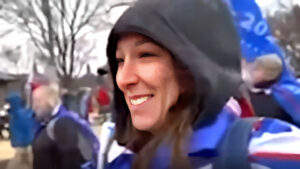
When Ashli Babbitt was shot and killed on January 6, 2021, the only member of Congress still in the House Chamber was Markwayne Mullin (R-Oklahoma) who refused to leave. When interviewed by the Wall Street Journal three weeks after the shooting, he stated that Lt. Michael Byrd “did what (he) had to do” and that by killing Babbitt he “saved a lot of people’s lives that day.”
On February 1, 2021 the Wall Street Journal article said investigators had already made a “preliminary determination” that the U.S. Capitol Police officer who shot Babbitt “shouldn’t be charged with any crimes in connection with her death…”
This determination was apparently made even before interviewing and getting statements from the three USCP uniformed officers who were guarding the eastern Speakers Lobby doorway until less than a minute before Babbitt was shot.
Given the lack of timeliness in conducting vitally important interviews, leading questions to seemingly pave the way to a predetermined outcome and a stunning disregard for available evidence (as contained in this report), it appears the fix was in.
Lt. Byrd’s attorney, Mark Schamel stated, “There’s no way to look at the evidence and think he’s anything but a hero.” In Part 3 of this 4 part report, we’ll look at the evidence perhaps more closely that Schamel and investigators to see if we draw the same conclusion that Lt. Byrd was indeed a “hero.”
Part 2 of this 4 part report showed the events in the small vestibule outside the doorway to the Speakers Lobby. It also led us to just the last 20 seconds of Ashli Babbitt’s life. (Official reports say she was declared dead once she reached the hospital but reports at the scene indicate she passed away there.)
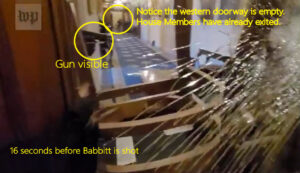
Because of the erroneous radio report that shots had been fired somewhere in the Capitol, Lt. Byrd, Sgt. McKenna and Officer Tyson remained shielded from the protesters behind the Speakers Lobby pillars. to protect themselves. There appears to have been no investigation into at least two erroneous “shots fired” reports that were sent throughout the Capitol police communications.
In Photo #27 notice that Lt. Byrd with weapon drawn is now guarding an empty hallway as the western doorway has cleared of House members. When Sgt. Lively noticed the members had left the Chamber, he completely changed his objective; now more concerned about the safety of the officers under his command, he moved them away from the doorway.
Like Sgt. Lively, Lt. Byrd could also see that the members had safely left. He also now knew that if protesters were armed and trying to shoot member of Congress elsewhere in the building, they were not among the group at the eastern doorway. If they had been armed they would have had a clear shot from one end of the Lobby to the other. It begs the question: Why were Byrd, Tyson and McKenna hiding behind cover when exiting House members were completely exposed and could easily have been shot? What’s “heroic” about that?
In his interview Officer Tyson stated that he took his position in the Speakers Lobby after “We got them out on the west side of the Lobby.” (P.51) He said “we,” meaning that he, Lt. Byrd and Sgt. McKenna had already safely removed the House members from the Chamber and Speakers Lobby areas. McKenna supported Tyson’s statement when he stated that just before taking their positions behind the pillars, “… we had just got all the members out.” (P.39)
This completely removes the “for the members protection” reason for shooting Babbitt.
Being positioned behind the second pillar gave Officer Reggie Tyson a good view of the northern wall on the other side of the doorway since he described Babbitt’s appearance as she was shot. He added the protesters were using “a helmet” and “some sticks” so he had a good view of the entire doorway area.
When asked during his interview if he “saw any other Capitol Police Officers or any other kind of security personnel on the other side of the, of the doors? His response was somewhat incoherent (P.55) but he did convey that he had seen three officers (at the doorway) who had gone down the stairway: “ So I don’t know if the officers went down the steps. Cause it was probably three officers for the most.”(sic)
He was not asked why he and the other plainclothes officers in the Lobby didn’t make their presence known to the Capitol policemen on the other side of the doorway; why they remained hidden why the uniformed guys stood unprotected directly in front of the protesters.
Officer Lanciano was asked when he was standing at the doorway if he could hear “any type of commands coming from the other side of the door … behind the barricade?” Lanciano responded, “No, I didn’t hear anything.” (P. 122)
Likely the person closest to Lt. Byrd for all but the last 30 seconds of the confrontation was Officer Yetter, no more than six to eight feet away. He was asked by IAD interviewers the same thing, did he hear “anybody on the other side of the doors saying anything?” Yetter replied, “There was no communication from my perspective, um, from the officers within that door area from separated by the door to us (sic).”(P.97)
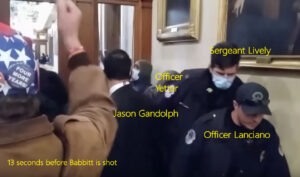
In Photo #28, USCP Officers Yetter, Lively and Lanciano are seen walking down the stairway now just 13 seconds before Babbitt is shot.
As the three uniformed USCP officers moved away from the northern wall and toward the stairway as pushed by Officer Kyle Yetter, a disgusted Ashli Babbitt has made her way toward the most destructive of the mob, Zachary Alam.
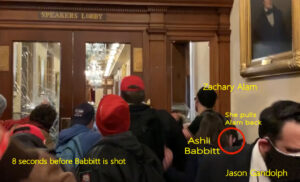
As Zachary Alam destroys the northern sidelight window by pushing it through the opening and seeing as the USCP officers leave the scene, Babbitt has had enough and takes it upon herself to stop his destruction. In Photo #29 she can be seen grabbing his backpack and pulling him back from the window’s opening. By doing so it is possible she unknowingly saved his life as he might have tried to climb through the sidelight himself.
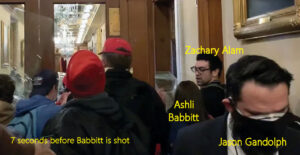
In Photo #30 Alam turned around and disgustingly saw it was the irritating Babbitt who pulled him back.
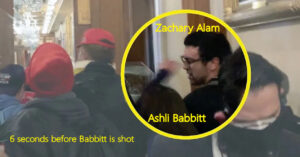
Photos #31 and 32 show former military Security Force (MP) member Ashli Babbitt performing the act that completely separated herself from the destructive mob.
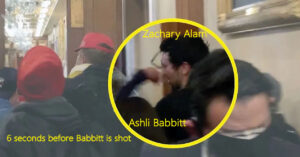
The left-handed Air Force veteran threw a left hook into the nose of Zachary Alam shown here knocking his glasses off in Photo #32.
To claim that Babbitt was aligned with this group as the Department of Justice did after she took it upon herself to attack its ringleader is incomprehensible. Either its investigation was shoddy or it was predetermined.
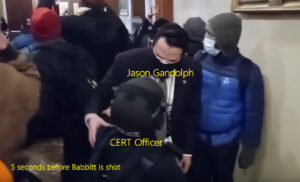
While Babbitt was literally assaulting Alam, as seen here in Photo #33 Jason Gandolph from the Sergeant of Arms office was still talking with one of the CERT officers. That clearly delayed the tactical team’s move to secure the doorway though it may not have been a priority. What can’t be seen from this angle is that after the punch to Alam, Babbitt is now moving quickly toward the window sidelight opening.
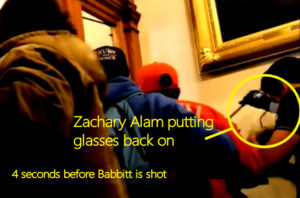
Here in Photo #34, a screenshot from a completely different angle, we can see Alam putting his glasses back on a few feet from the sidelight.
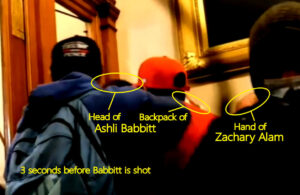
Photos #35 and #36 are also screenshots from the same angle.
In Photo #35 we can still see Alam’s hand along with the top of the head and Babbitt’s backpack as she begins her fateful climb through the sidelight window.
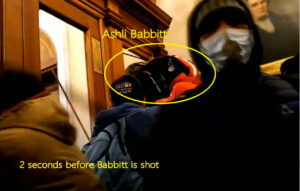
No one knows why Babbitt attempted to climb through the opening into the Lobby. She obviously never saw Byrd’s gun extended nor heard any commands. The most likely explanation is she was attempting to get away from the more violent protesters that she had now alienated. She should have just followed Lively, Yetter and Lanciano down the stairway but she didn’t. Here she is in Photo #36, just about to poke her head through the open windowpane. It was a stupid move — but it shouldn’t have been a fatal one.
Sergeant McKenna said in his interview (p.37) that he could see that the protester coming through the window was female: “It was a white female, black hair. Uh, she was wearing a gray sweater.” He said he saw no weapon.
He said he heard a lot of shouting, “Get back, get back” after Babbitt had been shot and from the other side of the doorway. He said he also then began yelling, “Get back.”(P.41)
Though his attorney, Lt. Byrd said he had shouted, “Get back” multiple times which was supported by Officer Tyson. No civilian or police officer on the other side of the doorway heard that directive. Congressman Mullin said he heard Lt. Byrd say he would “shoot” but no one else heard that command. Mullin also said he thought he heard two shots.
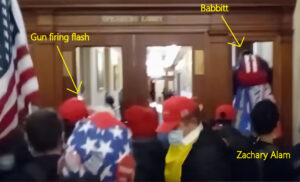
Photo # 37 shows as far as Ashli Babbitt got into the Speakers Lobby. As Alam looks at her, Lt. Byrd fires his weapon from less than 10 feet away. Through his attorney, Lt. Byrd “said” he saw the small, unarmed woman as “a threat” — and decided to kill her. A threat to what or whom was never stated. The .40 caliber bullet entered under her left collar bone. The trajectory of the shot did immediate catastrophic damage. She had no chance.
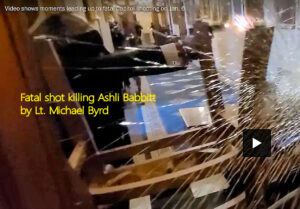
John Sullivan’s (JaydenX) video captured the fatal shot by Lt. Byrd shown here in Photo #38. Neither Sgt. McKenna nor Officer Tyson were sure that it was Byrd who fired the shot yet the only other possibility seems that it had to be from one of the protesters.
Officer Yetter was asked if at any point he considered using his gun when the protesters were right in his face. He replied: “Uh, no.” He was then asked why not. Yetter replied, “…you can’t shoot into an empty crowd. That’s so wrong.”(P.99)
All three uniformed officers in front of the doorway had firearms. And although all three were bumped and pushed, none considered drawing his weapon let alone using it. Lt. Byrd was not assaulted, nor threatened yet he had no qualms about shooting the first person who tried to enter the Lobby.
When the Capitol Police announced its determination that the shooting was lawful, its Office of Professional Responsibility wrote: “An officer may use deadly force only when the officer reasonably believes that action is in the defense of human life, including the officer’s own life, or in the defense of any person in immediate danger of serious physical injury. The actions of the officer in this case potentially saved members [of Congress] and staff from serious injury and possible death from a large crowd of rioters.”
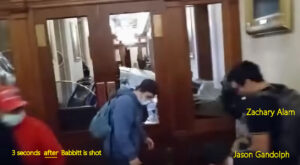
In his interview, Officer Tyson stated that immediately after Babbitt was shot “she falls and we just get behind cover and we, we can see if anybody else is trying to make their way through.” It means that as they kept their guns drawn, each person who tried to come through that window would have been shot as well. In photo #39 notice that Lt. Byrd has retreated back behind his pillar ready to shoot the next person who dared enter the Lobby.
When asked what happened after the shooting, Tyson responded: “Um, we kind of, we, we, we took off because it was more people were still trying to get in the House main door.” (sic) (P.56)
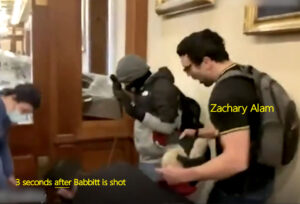
In photo #40 Mr. Gandolph has begun attending to Babbitt in an attempt to stop her bleeding. Zachary Alam is stunned, no longer looking so cocky and violent. Shortly after this screenshot, Alam swiftly runs down the stairway in fear.
Interestingly Mr. Gandolph was interviewed just hours later on Jan. 6 at 7PM but the three USCP officers he was with (Yetter, Lively and Lanciano) were not questioned for another month.
In effort to again paint Babbitt as one of the violent protesters, the MPD Internal Affairs officer asked, “…did she break the windows out? Gandolph responded falsely, “I mean, yes.”
Questioner: “She was punching windows?” Gandolph answered, “Sure.” (P.218) It was a definitive response. He either had a fuzzy recollection of the incident or chose to give an answer the interviewers wanted to hear. Video evidence clearly shows his response was not true.
At not one point did Ashli Babbitt attempt to hit the windowpanes or break any glass. This erroneous statement by Gandolph may have been quite important in the DOJ’s justification that her killing was a “good shoot” by Byrd. It supported the overarching narrative that Babbitt was a violent protester who got what she deserved.
Had there been any portrayal of her as a lone woman tying to stop the destruction by herself and then flee from an angry, violent mob after making enemies with its ringleader, the public perception of the incident may have been very different.
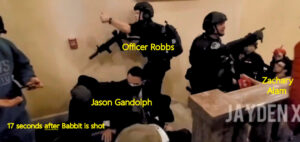
In Photo #41 as Mr. Gandolph tries to offer aid to Babbitt, Alam can be seen retreating down the stairway while the CERT team, along with Yetter, Lively and Lanciano, now becomes considerably more assertive and move the protesters away from the area. CERT Officer Robbs is at the top of the stairs, sees that the shot was fired by a fellow police officer and gives the thumbs up to Lt. Byrd.
The respective positions of Officer Robbs and Lt. Byrd is noteworthy. They can see each other: Byrd in his concealed position inside the Speakers Lobby and Robbs standing along the wall at the top of the stairway about eight feet from the doorway. Given that uniformed USCP officers were standing along that very wall less than 20 seconds before he fired his weapon, it is not believable that Lt. Byrd could not see any police officers on the other side of the doorway.
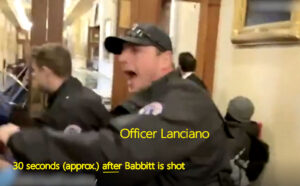
In this screenshot (Photo #42) the no longer passive Officer Lanciano has come back up the stairs to control the crowd as he screams “Get the fuck back! Go, go! Everyone get the fuck away.” Most of the crowd of protesters listen and retreat although a few of the most agitated did not.
In his interview, Officer Yetter said that as they were walking down the stairs, he heard the gunshot but curiously stated, “We went down the stairs and there was actually a wall, um, that would have protected us from the round that was fired.” (P.100)
If he hadn’t assumed that the shot was fired from inside the Lobby or from the direction of Lt. Byrd, how would he have known the wall provided protection?
Sgt. Lively said the crowd got quiet shortly after the shooting and then many officers descended upon the scene, “like thirty officers.” They moved the protesters away. (P.73)
This area was now a crime scene.
In the conclusion of this report, we’ll see that photos taken at the scene show the area was clearly altered after the shooting. And though it did have an impact on the overall DOJ narrative that Babbitt was a dangerous, violent protester and that Byrd was justified using lethal force to protect exposed House members from her and her mob, there was never any investigation as to how it occurred or by whom.

